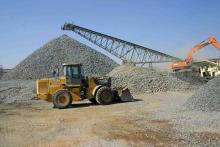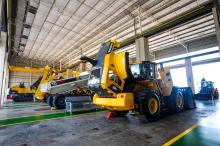
Economist Dr Roelof Botha says that nearly all major building and construction indicators in the country show a V-shaped recovery which translates to rising demand for materials such as cement, sand, stone, dimension stone and other materials used in construction projects.
Speaking during a webinar on behalf of surface mining industry association Aspasa that hosted more than 250 online delegates, Botha announced the findings of the Afrimat Construction Index (ACI) which provides a snapshot of the surface mining, industrial and construction industries. It reflects a realistic picture of the industry based upon statistics and figures reported on a quarterly basis.
Underpinning the comments of Afrimat CEO Andries van Heerden that the company and the industry are in a strong position to grow, Dr Botha said that following the economic disaster caused by the pandemic, companies should not get drawn into managing the calamity that happened in April, but rather focus on recovery.
“All indications are that we are experiencing a V-shaped recovery that means that as quickly as the market collapsed, it is recovering," said Dr Botha. "The Rand is recovering, bonds are bouncing back and the outlook is looking brighter by the day. Although the Rand is expected to remain volatile we expect it to continue strengthening as the pandemic tapers comes under control.
“Fear factors such as the GDP to debt ratio climbing is to be expected and is not unique in the world. But, compared to many other countries, including some developed ones, ours is manageable and fundamentals are in place to recover. And the V-shaped recovery in South Africa is not unique either, it is happening in all world economies. With increasing demand, commodity prices are also increasing in a V-shape recovery which spells good news for the mining industry."
“It is also reflected in overall mineral sales which are at all-time highs."
Dr Botha said that, added to these sentiments is the good news of South African Government’s large-scale COVID relief projects which will kick-off with 62 large infrastructure projects worth hundreds-of-billions of Rands in an attempt to kick-start the economy and provide work for tens of thousands of employees.
At the end of 2020, Afrimat - which supplies construction and industrial minerals ranging from mining and aggregates, metallurgical dolomites, agricultural lime, concrete products (bricks, blocks and pavers) to readymix - released the findings of the ACI for the third quarter of 2020.
The ACI is a composite index of the level of activity within the building and construction sectors, compiled by Dr Roelof Botha on behalf of Afrimat. Following the sharp decline in construction activity during Q2 2020, induced by the lockdown regulations, Afrimat says the ACI staged a remarkable improvement in the third quarter, moving back to above the 100-mark level of the base period (i.e. the first quarter of 2001).
During the worst of the lockdown, the construction sector followed the general trend of a severe downturn and is now also exhibiting a swift return to pre-pandemic levels of economic activity. During July to September, the quarter-on-quarter change in the ACI amounted to 69.1%, marginally higher than the recovery of 66.1% in the gross domestic product (GDP).
Afrimat adds that it must be noted that compared to the third quarter of 2019, the ACI remains down by 6.7%, compared to the year-on-year decline in the GDP of 6%. It says what is particularly encouraging, however, is that the four-quarter average of the ACI has managed to remain above the base period level of 100.









